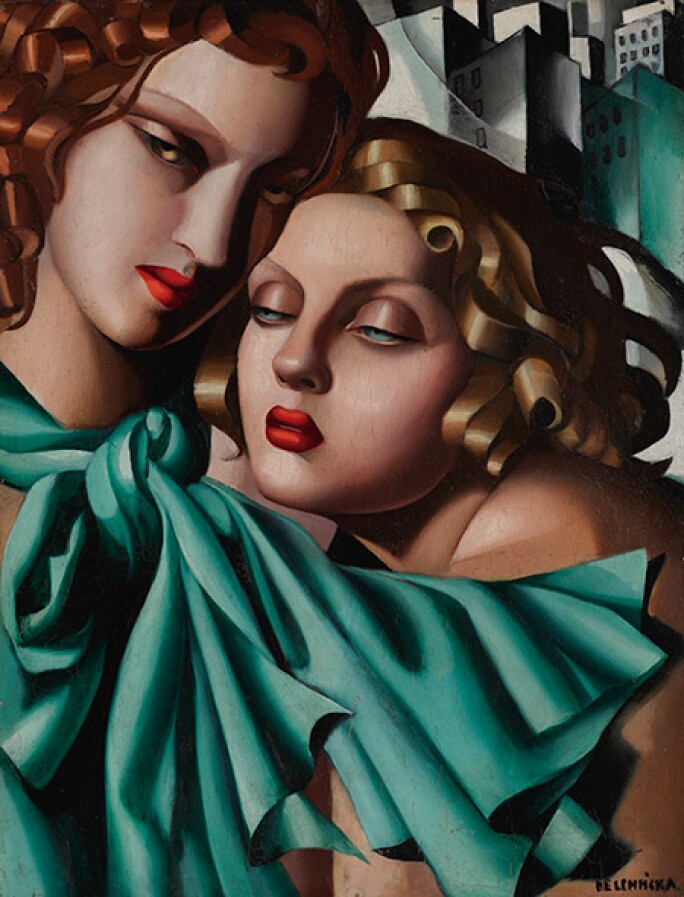Born in Poland but with a youth spent in St Petersburg, Tamara de Lempicka created her own unique aesthetic that prompted a critic to don her as the “modern Vigée le Brun.” In 1918, she moved to Paris and quickly began exhibiting her work in the Paris salons of 1922. Impressed by the Cubists and their deconstruction of form, she applied similar techniques to her own works. Though loosely tied to the geometric aesthetic of Cubism and the proportionality of neo-Classicism, Lempicka's paintings – characterized by her razor-sharp draughtsmanship, theatrical lighting and sensual modeling – was unlike that of any artist of her day. Her striking depictions of women, including the tantalizing Les Jeunes Filles and La Dormeuse, have come to personify the age of Art Deco.

Lempicka painted Les Jeunes Filles on a small panel that appropriately reflects the intimacy and quiet intensity of the moment she has enshrined upon it. In Les Jeunes Filles, every curve of the figures' flesh is rendered with imperceptible brushstrokes. Their skins appear to be incandescent, as if bathed in silver moonlight, and their hair glows with a metallic sheen. Lempicka was receptive to the influence of her colleagues in Weimar Germany, and she readily incorporated the hyper-realism of the Neue Sachlichkeit into her work. But it was her love of the precision and classicism of the Italian Renaissance that had the most profound impact on her compositions. Lempicka frequently acknowledged her indebtedness to the Italian Old Masters and how their style profoundly impacted her art: "I discovered Italy when I was a youngster and my grandmother took me away from the cold climate of Poland, where I was born and lived, to take me to the sunny cities of Florence, Rome, Naples, Venice and Milan. It was under her attentive guidance that my eyes took in the treasures of the Italian old masters, from the Quattrocento, the Renaissance" (as quoted in A. Blondel, Tamara de Lempicka [exhibition catalogue], Mexico City: Museo de Bellas Artes, 2009, p. 22).

While much has been written about Lempicka's reverence for the Old Masters, equally important to her as an artist were the aesthetic forces of her era, the most influential of which was the American film industry. Lempicka was enthralled with the mystique of Hollywood, eventually moving there in the 1940s with her second husband, Baron Kuffner. She invited film crews to her studio in Paris, where she staged grand entrances and posed for pictures with all the theatricality and panache of a silent film star. One oft-repeated anecdote is that Lempicka was thrilled to be mistaken once for the film actress Greta Garbo. The artist was enamored by this type of modern glamour, and it is no accident that the models in her portraits often resemble film icons from the early days of Hollywood. These platinum and mahogany bombshells, depicted in a moment of tangible intimacy and with brightly colored lips, call to mind the passively seductive poses of 1920s and 1930s silver-screen legends.
Germain Bazin characterized Lempicka's style in these terms: ''The linea serpentina, to sixteenth-century Italian theorists the supreme expression of beauty, animates Tamara's figures: with bodies twisting from top to toe, they touch the edge of the painted surface at various points . . . . A painting by Tamara is generally presented like a bas-relief with a single, powerful figure filling the whole canvas, (G. Bazin, reprinted in Tamara de Lempicka, Art Deco Icon [exhibition catalogue], London: Royal Academy of Arts & Vienna: Kunstforum, Wein, 2004–05, p. 19).

Tamara de Lempicka's Les Jeunes Filles will be offered in Sotheby's Impressionist & Modern Art Evening sale (14 May, New York). Estimate $4,000,000–6,000,000. Learn more about the artists that bring the spirit of Fearless Now to life.





